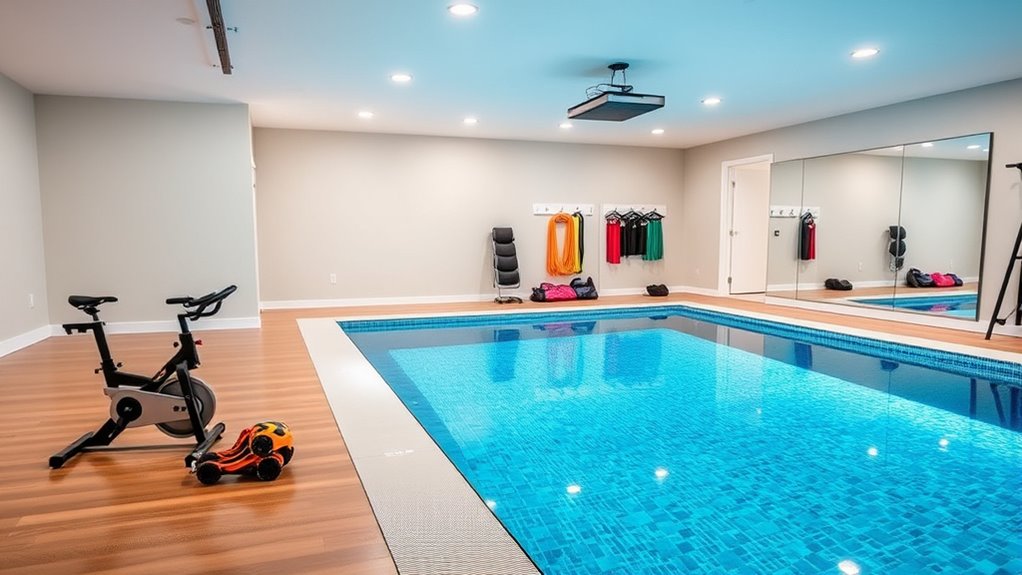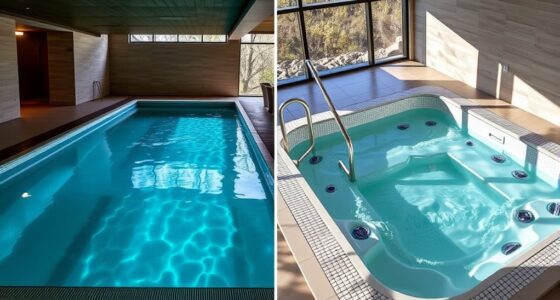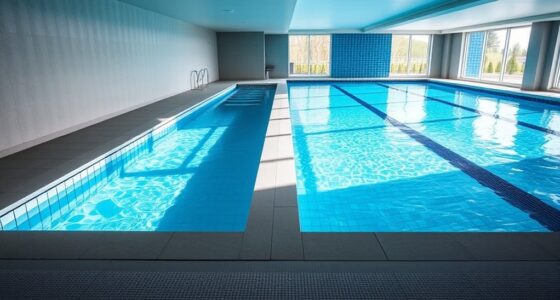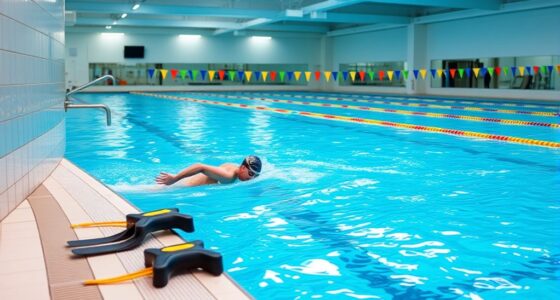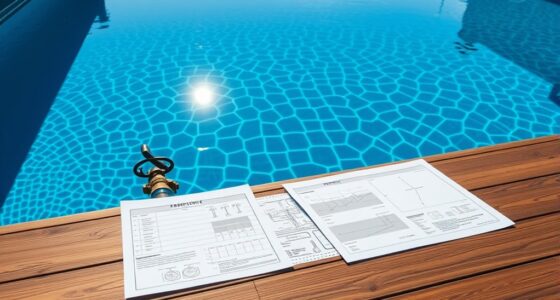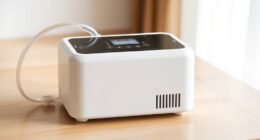To train for a triathlon at home, invest in a spacious, durable endless pool with adjustable water flow and low noise levels to match your fitness needs. Equip it with waterproof timing tools, resistance bands, and safety gear. Design a compact, safe workout area with proper flooring and storage, and maintain water chemistry regularly. Successful training depends on routine maintenance, monitoring progress, and staying motivated—continue exploring ways to optimize your home setup for peak performance.
Key Takeaways
- Choose a spacious, durable, energy-efficient endless pool with adjustable flow for realistic swim training and comfort.
- Optimize your indoor space with safety features, proper flooring, and space-saving storage for an organized, hazard-free environment.
- Maintain water quality through regular chemical testing, cleaning, and filtration to ensure safe, clear training conditions.
- Incorporate essential accessories like waterproof timers, resistance bands, and safety gear to enhance workout effectiveness.
- Perform routine equipment maintenance and water chemistry checks to ensure peak performance and injury prevention during triathlon prep.
Choosing the Right Endless Pool for Triathlon Training
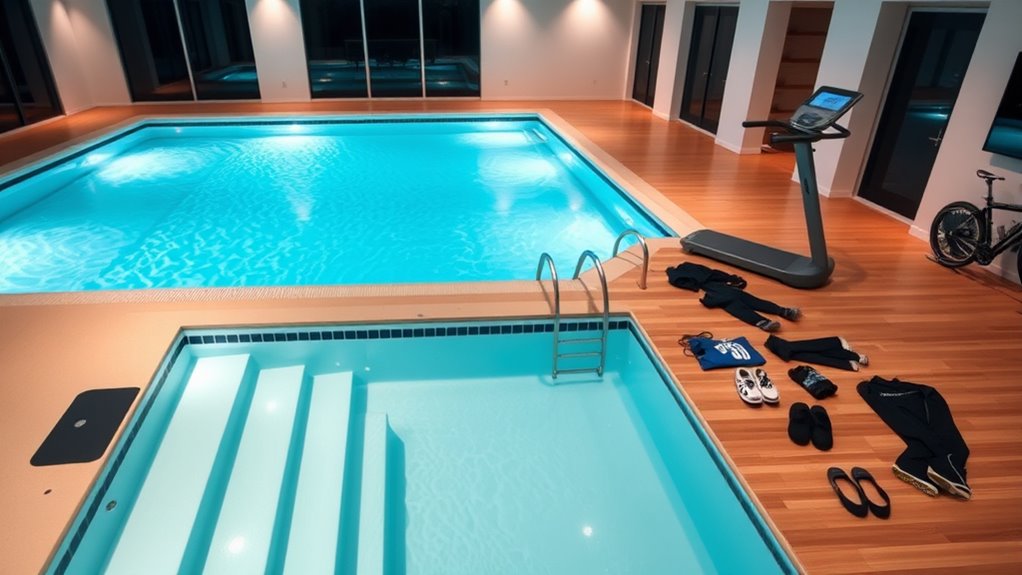
Choosing the right endless pool is an essential step in setting up an effective triathlon training space at home. First, consider the pool’s size and depth to guarantee it accommodates your height and allows for realistic swim strokes. A larger pool offers more space to simulate open-water conditions and perform interval training comfortably. Look for adjustable water flow speeds to match your current fitness level and target intensity. Noise levels matter too—select a model with quiet operation so it doesn’t disrupt your daily routine. Durability and build quality are indispensable, especially if you plan to train regularly. Finally, check for energy efficiency to keep operational costs manageable. Picking the right endless pool will give you a versatile, reliable tool for triathlon-specific swim training, no matter your skill level. Additionally, the floating on water feature can enhance your training experience by providing a more realistic simulation of open-water swimming.
Essential Equipment and Accessories for Your Setup
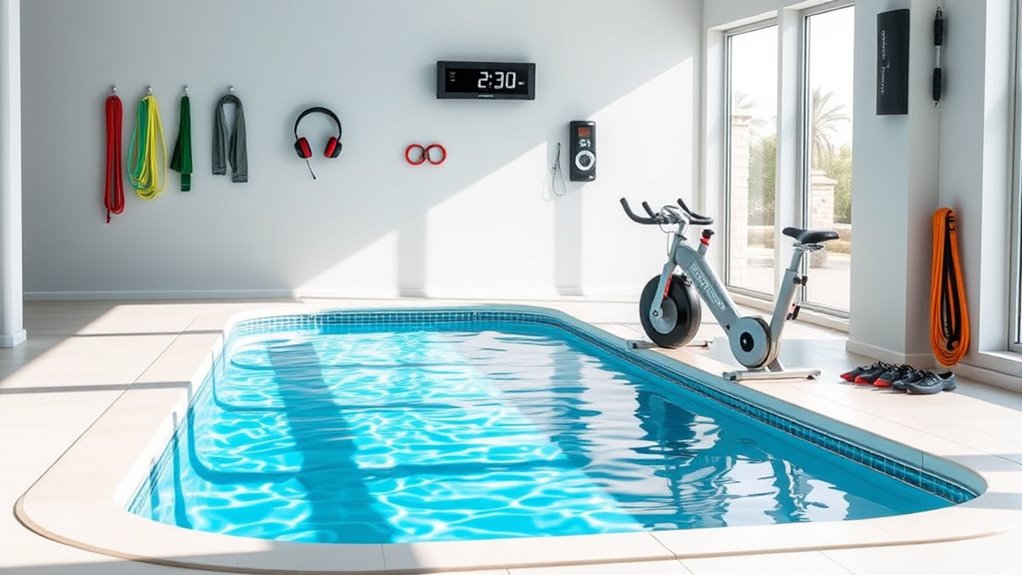
To create an effective at-home triathlon training setup, you’ll need essential equipment and accessories that enhance your workouts and guarantee safety. A high-quality waterproof stopwatch or fitness tracker helps you monitor your pace and progress. Invest in a comfortable, non-slip pair of running shoes suited for treadmill use or outdoor runs. Resistance bands and dumbbells add strength training options without cluttering your space. A foam roller or massage stick helps prevent injuries and speeds recovery. Consider a hydration station or water bottle holder to stay fueled during long sessions. Safety gear like a pool ladder, handrails, and a first aid kit are crucial for safe training. Lastly, a sturdy, vibration-absorbing mat protects your flooring and provides stability during exercises. Incorporating an understanding of eye patch benefits can help you maintain eye health during extended training sessions or recovery periods.
Designing a Space-Efficient and Safe Training Area
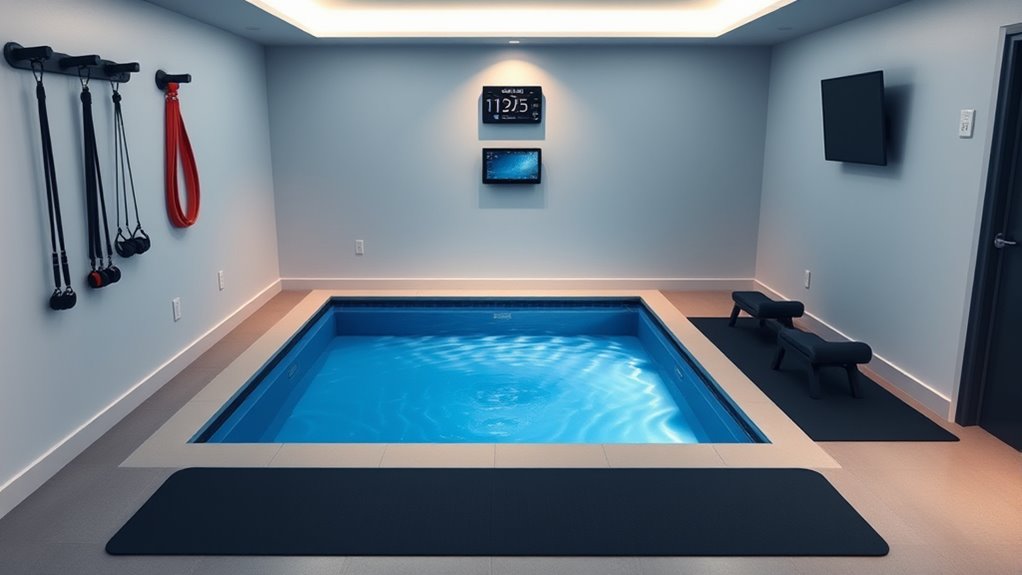
To create a safe and efficient training space, you need to consider ideal room dimensions that fit your workout needs without feeling cramped. Make sure to implement safety precautions like proper flooring and clear pathways to prevent accidents. Using space-saving storage ideas helps keep your area organized and maximizes available space for your exercises. Incorporating scenic views and outdoor seating can also enhance your training environment, making your workouts more enjoyable and motivating.
Optimal Room Dimensions
Designing a space-efficient and safe training area at home starts with selecting the right room dimensions. You’ll want a space that comfortably fits your endless pool, allowing for easy movement around it. A minimum of 12 feet in width and 15 feet in length works well, giving you enough room for swimming, stretching, and equipment placement. Ceiling height matters too—at least 8 feet—to prevent feeling cramped and to accommodate any overhead activities or equipment. Avoid rooms with sharp corners or obstructions that could cause injury. Ensuring proper clearance helps you perform exercises safely and comfortably. Keep in mind that larger rooms offer more flexibility, but even smaller spaces can work with smart layout choices. The goal is a balanced, accessible area that encourages consistent training. Incorporating appropriate safety measures further enhances your workout environment.
Safety Precautions Ensured
Ensuring safety in your home training area requires careful planning and attention to potential hazards. Start by choosing a flat, non-slip surface to prevent slips and falls. Clear the area of clutter, loose cords, and sharp objects that could cause injury. Install sturdy barriers or fencing around the pool to prevent accidental falls, especially if children or pets are nearby. Make sure your equipment is properly maintained and securely placed to avoid malfunctions. Adequate lighting is essential to clearly see your surroundings and avoid missteps. Keep a safety kit nearby, including a first aid kit and a phone for emergencies. Regularly inspect the space for hazards, and don’t push beyond safe limits—prioritize safety over intensity to prevent injuries. Incorporating mindfulness practices can also help you stay aware of your environment and respond promptly to any safety concerns.
Space-Saving Storage Ideas
Maximizing your training space involves clever storage solutions that keep your area organized and safe. Efficient storage prevents clutter, reduces risk of injury, and makes your workouts more enjoyable. Consider these ideas:
- Wall-mounted racks for towels, goggles, and swim caps, freeing up floor space.
- Foldable or collapsible equipment like resistance bands and mats that tuck away when not in use.
- Overhead storage bins for smaller items, keeping them accessible but out of the way.
- Incorporate emotional alignment techniques to stay motivated and positive throughout your training journey.
Creating a Versatile Workout Routine for All Disciplines
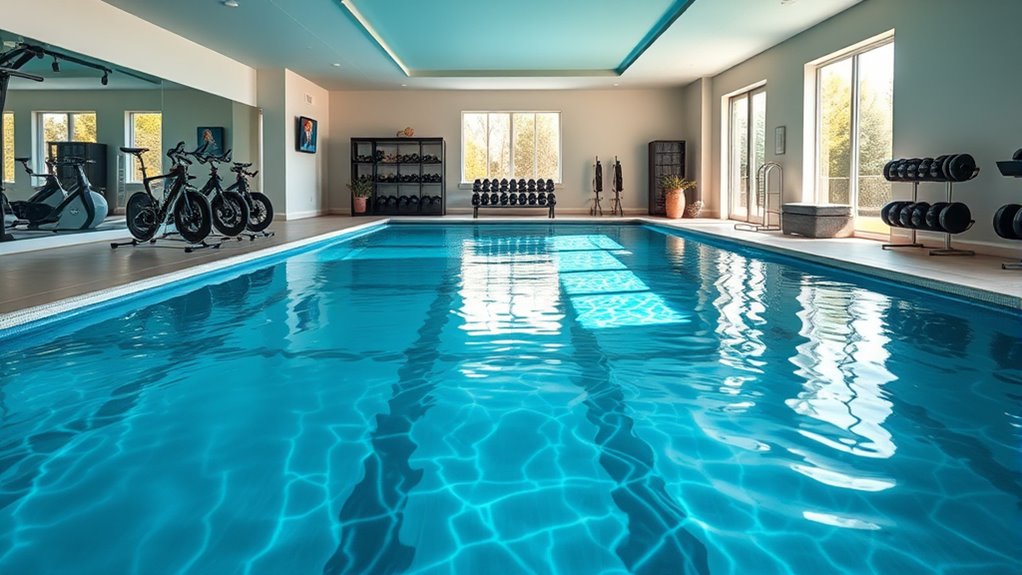
Creating a versatile workout routine that covers all triathlon disciplines guarantees you’re prepared for race day and can adapt to your schedule. To achieve this, balance your training by alternating swimming, cycling, and running sessions throughout the week. Focus on building endurance in each discipline, but also include interval training to boost speed and stamina. Incorporate brick workouts—doing two disciplines back-to-back—to simulate race conditions and improve progression. Keep your sessions varied to prevent boredom and target different muscle groups. Use your Endless Pool for consistent swimming practice, and complement it with cycling and running outside or on a treadmill. Additionally, incorporating high-quality training gear can enhance your performance and motivation. By structuring your routine thoughtfully, you develop overall fitness, prevent burnout, and stay motivated, ensuring you’re ready for every stage of your triathlon.
Integrating Cross-Training and Strength Exercises
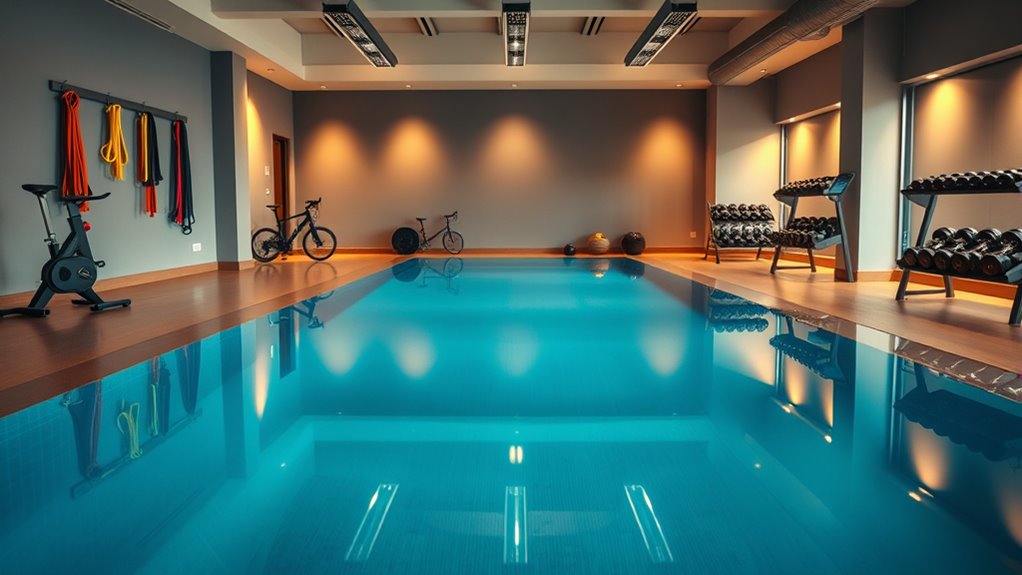
Incorporating cross-training and strength exercises into your triathlon routine enhances overall performance and reduces the risk of injury. These workouts build muscle, improve endurance, and balance your training. To get started, consider these activities:
- Cycling or Spin Classes – Mimic bike training with stationary cycling, boosting leg strength and cardiovascular fitness.
- Weight Training – Focus on core, glutes, and upper body to support swimming, cycling, and running.
- High-Intensity Interval Training (HIIT) – Short bursts of intense activity improve stamina and metabolic conditioning.
- Incorporate targeted muscle strengthening exercises to enhance muscle endurance and prevent imbalances that could lead to injury.
Integrating these into your schedule ensures you’re well-rounded, prevent overuse injuries, and develop the muscle groups necessary for each discipline. Balance is key for a successful triathlon at home.
Maintenance Tips to Keep Your Pool in Top Condition
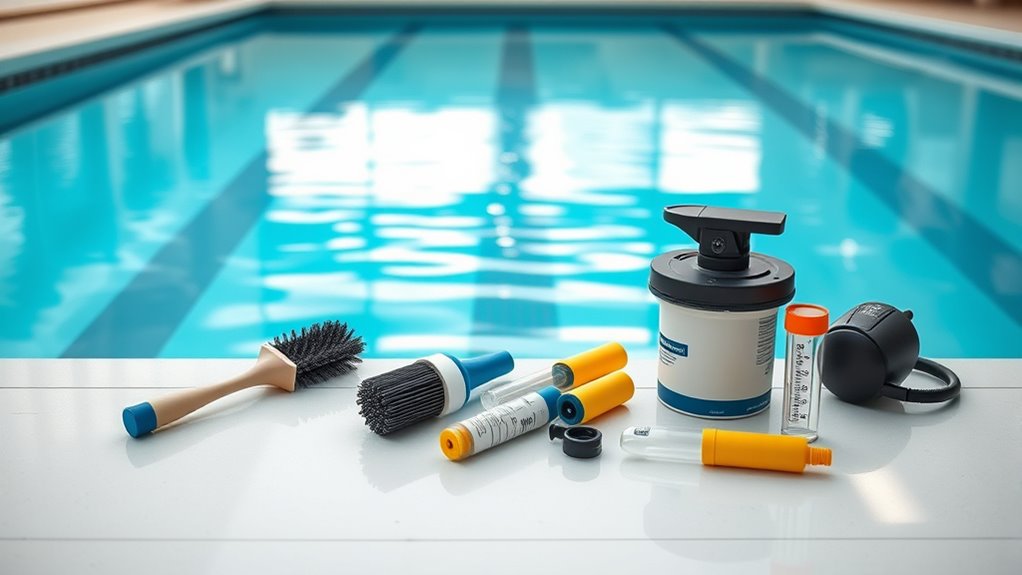
Maintaining a clean and well-balanced pool is just as important as your training routines. Regularly check your water chemistry—pH, alkalinity, and sanitizer levels—to prevent algae growth and keep water safe. Use a reliable test kit weekly and adjust chemicals as needed. Skim the surface daily to remove debris, and vacuum the pool floor weekly to prevent buildup. Clean the filter regularly to ensure proper circulation and water clarity. Keep an eye on the pump and check for leaks or unusual noises. Cover your pool when not in use to minimize dirt and debris. Performing these routine maintenance tasks keeps your pool in top condition, reduces the risk of equipment failure, and ensures a smooth, safe training experience every time. Additionally, being aware of your performance cookies can help you better understand how your pool setup influences your training progress.
Tracking Progress and Staying Motivated at Home
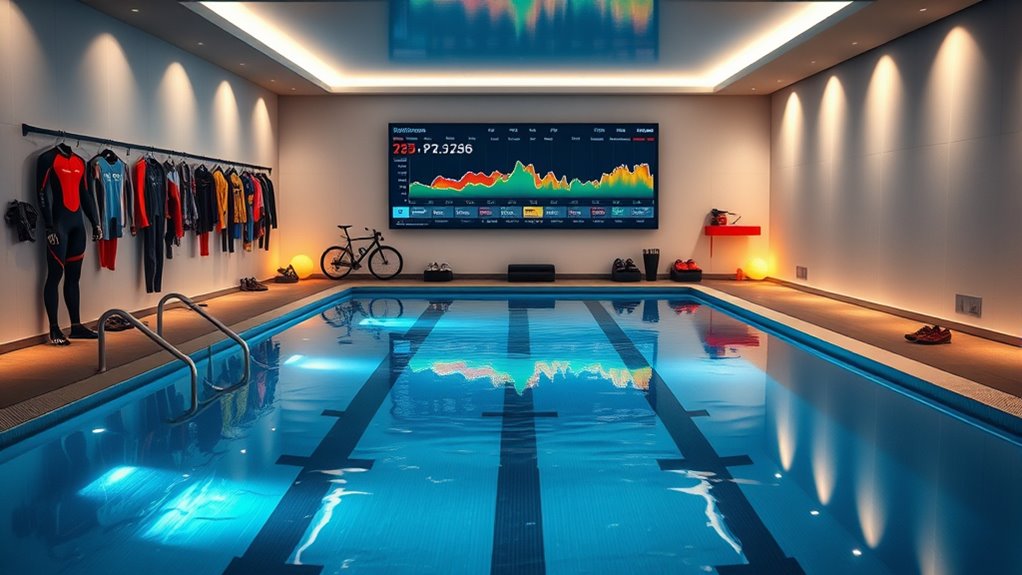
Tracking your progress and staying motivated at home can be challenging, but setting clear goals and monitoring your performance makes a big difference. When you know exactly where you stand, it’s easier to adjust your training and stay focused. To help you stay on track:
- Use a fitness app or journal to record your workouts, times, and improvements.
- Set specific milestones, like completing a certain number of sessions or reaching target paces.
- Celebrate small wins to boost your motivation and reinforce your commitment.
- Leveraging performance insights from tracking tools can further optimize your training efficiency.
Frequently Asked Questions
How Much Space Is Needed for a Triathlon-Specific Endless Pool Setup?
You’ll need about 15 to 20 feet of length, 8 to 10 feet of width, and at least 4 feet of clearance around the pool for safe, effective training. Make sure you have enough space for comfortable movement and accessories like bikes or treadmills nearby. Measure your available area carefully, and consider future expansion or additional equipment needs to guarantee your setup remains functional and safe during your triathlon training.
What Safety Features Are Recommended for At-Home Triathlon Training Pools?
You should prioritize safety features that keep you secure during intense training. Install non-slip flooring around your pool, add sturdy handrails, and ensure easy access with steps or ladders. Consider an emergency shut-off or safety alarm, and always keep a first aid kit nearby. These measures create a safer environment, allowing you to push your limits confidently, knowing help is just within reach if needed.
Can the Pool Accommodate Multiple Users of Different Skill Levels?
Yes, the pool can accommodate multiple users of different skill levels. You can set adjustable speeds and resistance levels, allowing beginners to practice at a comfortable pace while advanced swimmers push their limits. Make certain to establish clear guidelines for usage to guarantee safety and comfort for everyone. You might also consider scheduling separate training times or zones within the pool to prevent congestion and ensure effective workouts.
What Are the Best Times of Day to Train for Optimal Results?
You should train early in the morning or late evening for ideal results. Early workouts boost your metabolism and energy levels for the day ahead, while evening sessions help you wind down and improve sleep quality. Consistency matters most, so choose times when you’re naturally more alert and less likely to be interrupted. Avoid peak heat hours to prevent fatigue and dehydration, ensuring you get the most out of each session.
How Do I Prevent Water Quality Issues With Frequent Use?
To prevent water quality issues with frequent use, you should regularly test and balance the pH and sanitizer levels. Use a high-quality water sanitizer like chlorine or bromine, and shock the pool weekly to eliminate bacteria. Run the filtration system for at least 8-12 hours daily, especially after workouts. Keep the pool clean by skimming debris and brushing the walls, and change the water periodically according to manufacturer guidelines.
Conclusion
Ready to take your triathlon training to the next level from home? With the right endless pool setup, essential equipment, and a solid routine, you can build strength and endurance without leaving your house. Keep your space safe and well-maintained, track your progress, and stay motivated. Isn’t it time you turned your home into the ultimate triathlon training hub? Start today and watch your skills soar—your future self will thank you.
